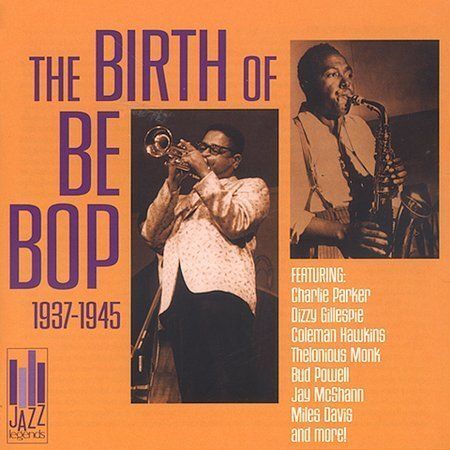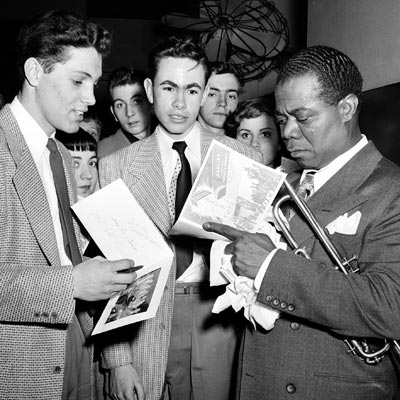Overview and Thesis
During the 1940s, after the peak of jazz hit around the 1920s and 1930s, a new genre of music was created: bebop. Swing and big band jazz ruled the black community in previous decades, as their high-tempo danceability made them suitable background noise to the Harlem renaissance. The Black community enjoyed its momentary opulence with music that matched the celebratory tone. However, as this era began to fade, another strain of Black consciousness emerged that would seek to flip the established trends of jazz music on their head. Bebop, and the hipster subculture that came with it, was like nothing that had been seen before. Although the hipster subculture started as an expression of Black creativity that grew against the grain of mainstream jazz, its uniqueness led to its eventual upheaval by young white people.
Bebop
Bebop musicians of the 1940s and 50s challenged many cultural standards, not only within the black community but outside of it as well. Compared to swing and big band jazz, bebop jazz was more experimental. It was meant to be listened to, but not danced to in a club or lounge. There was lots of improvisation and complex melodies, individual artists exploring their creativity on top of one another within a single song using repeated phrases. The bebop persona was calm, cool, and sophisticated, a direct contrast to the happy-go-lucky and vapid caricatures depicted in minstrel shows representing Blackness.

According to Ross Russell, owner of Dial Records, “Bebop is a music of revolt…. It reasserts the individuality of the jazz musician as a creative artist, playing spontaneous and melodic music within the framework of jazz, but with new tools, sounds, and concepts.” Prominent bebop artists included Miles Davis, Charlie Parker, and Dizzy Gillespie.
Dizzy Gillespie

Arguably the most influential in the bebop genre was Dizzy Gillespie, who was credited with creating the genre alongside Charlie Parker. As Gillespie’s longtime disciple Jon Faddis wrote, “Charlie Parker was the designer (of bebop), but Dizzy was the cat who put it all down, like the architect.″ Gillespie was an accomplished trumpet player and performer, known for his eccentric and somewhat ridiculous behavior onstage. He was an adventurous musician, exploring the bounds of jazz and even venturing into other genres. For example, Gillespie produced Latin fusion music in his big band with Cuban conga player Chano Pozo. much of the hipster style was directly derived from his image, including his goatee, berets, and zoot suits.

Hipster Culture and Slang
The term “hipster” comes from “hepster,” originally used by Cab Calloway in his book, “The Hepster’s Dictionary.” According to Calloway, a hepster or hep cat is “a guy who knows all the answers, understands jive.” At the time, “hep” was used to describe someone who knew about the jazz scene and upcoming culture that went along with it. To be a hipster was to be in on the happenings of the new and creative Black consciousness. Hipsters were also known for their very relaxed lifestyles, indulging in mild drugs and relatively open ideas about sex.
The word “beat” was used after World War II by jazz musicians to mean exhausted, poor, and unfortunate. Jack Kerouac, writer of The Beat Generation, later twisted the term, saying that it signified, “beatitude, not beat up. You feel this. You feel it in a beat, in jazz, real cool jazz.” Other phrases coined by hipsters include “square,” “cats,” “nowhere,” “dig,” and “lame.”
The Rise of White Hipsters

Though the premise of hipster culture and bebop was meant to reflect a Black experience and push back against racial stereotypes, it was only a matter of time before it was absorbed by young white people. “White Negro,” a pamphlet written by Norman Mailer in 1957, describes hipsters as people “with a middle-class background (who) attempt to put down their whiteness and adopt what they believe is the carefree, spontaneous, cool lifestyle of Negro hipsters: their manner of speaking and language, their use of milder narcotics, their appreciation of jazz and the blues, and their supposed concern with the good orgasm.”
This movement of hipster ideals into white spaces ultimately defeated the purpose of its original message by removing its racial context. Even contemporary hipster culture of the twenty-first century is more of an attempt to simply diverge from mainstream white media in a way that is also inherently white, rather than an attempt to make something new with its own racial and social principles. Even now, white hipsters who pride themselves on their unique music taste and style are still practicing the tradition of their ancestors: stealing from Black culture.
Sources
https://complicatingqueertheory.wordpress.com/a-queer-ethnography-of-counter-culture-in-the-20th-century/bebop-jazz-hipstershepcats-and-the-emergence-of-the-beats/
https://apnews.com/article/a68907197deae0dfe69cfb470a967681
https://cnx.org/contents/bYlczNqu@1/Hipster-Subculture
https://mainstreamhipsters.weebly.com/1940s-hipsters.html


